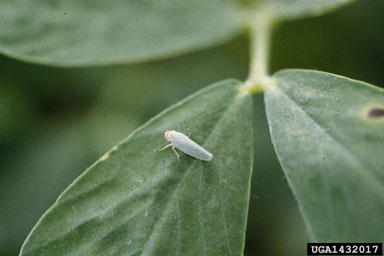
I have received some nice pictures of “hopper burn” on peanuts over the last week. The insect responsible for this damage is the potato leaf hopper (PLH). It is a tiny, bright yellow-green insect that feeds on the mid-vein of the leaf causing the characteristic “v” shaped yellowing at the tips of leaflets. Hopper burn is NOT caused by three cornered alfalfa hopper.
Potato leaf hopper is present in Georgia every year, but large populations and damage are usually sporadic. Because the insect is small (hard to see from the tractor) and many of our acres are not routinely scouted, leaf hopper infestations are often overlooked until the field begins to yellow from hopper burn. Potato leaf hoppers will not be seen while “scouting” from the truck.
The decision to treat a PLH infestation should consider the extent of the hopper burn and the number of adult and immature leaf hoppers present. Because hopper burn will persist even after the insects are gone, we need to confirm that the pest is still present before applying an insecticide to a damaged field. If nymphs are present (nymphs do not have wings and cannot fly), we know that the insects are reproducing and are likely to be around for awhile. Leaf hopper infestations often start near field borders, so scouts should not neglect these areas.
We tested the efficacy of several insecticides against PLH a couple years ago and found that they were easy to kill. The only problem is that most of the products we tested were broad spectrum insecticides (pyrethroid, OP, and carbamate) that can increase the risk of secondary pest outbreaks.
If you have questions about potato leaf hopper or other pest management issues in peanut, please contact your local UGA county Extension agent.
